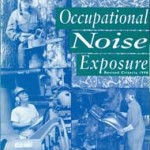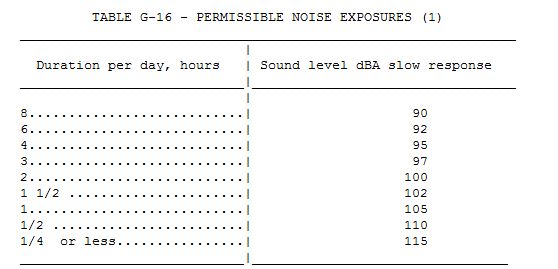Entries tagged with “dBA”.
Did you find what you wanted?
Wed 18 Sep 2013
Posted by admin under ACGIH, Exposure, Federal OSHA, Hearing Conservation, hearing protection, Management, NIOSH, Noise, OSHA, Personal Protective Equip (PPE), Safety Programs, TWA, Uncategorized
Comments Off on Hearing loss prevention, in construction
It’s sad to say, but many construction companies have not yet started a formal hearing conservation program. Their solution is to purchase the best earplugs, for the lowest cost, and give them away like candy.
As I’ve mentioned before: Sometimes OSHA’s rules are protective (meaning: you will be safe) and other times they are really not on par with the health research. Hearing loss and OSHA’s method of measuring noise are NOT protective to employee health (your hearing). For the best method of measuring noise, look to the recommended guidelines of the ACGIH. In order to get the exact parameters, you must purchase their Guide to Occupational Exposure Values (TLVs) booklet. It hasn’t changed (at least for noise) for a few years, but it is still the most up to date on health for your hearing. Here’s a summary of some differences:
- Exchange rate (how noise doubles and is averaged over time)
- OSHA uses 5, ACGIH uses 3 >>which means noise doubles every 5, or 3 dB increase
- this makes a BIG difference in your accumulated average noise level (TWA).
- Exposure Limit, or Criterion Level
- OSHA says 90 dBA, ACGIH says 85 dBA
- Doesn’t seem too different (-5), but remember noise is logarithmic and it’s measured different by OSHA & the ACGIH
NIOSH also has some guidelines, which are very similar to the ACGIH.
There are some strong benefits to having a hearing conservation program. Here are some examples and suggestions for bettering your own program.
If you have worked in construction for any period of time, you know how loud it can be, and how much exposure is out there. Don’t assume working in this industry that hearing loss will to happen to you. Do something about it. Here’s a presentation from CDC/NIOSH a few years back on how to start.
Mon 22 Oct 2012
As you might be aware, there is a loudness of noise which your ears cannot be protected against. Your body’s system of preventing the sound waves from entering your ear are just too much for it to handle. As the noise (sound pressure) hits your inner ear the bones convert the physical energy (noise) into a chemical & neurological process so you are able to hear. Ear plugs and ear muffs are not sufficient enough to protect against the amount of noise exposure.
However! Sometime in the future we might have a pill to prevent this type of hearing loss.
Researchers have found that the chemicals, D-methionine, ebselen & N-acetylcysteine, battle chemical stress on your ears.  We are still a long way from being able to take a pill to avoid hearing loss. They must go through more testing and the FDA approvals.
But, isn’t that cool!?
Thu 4 Oct 2012
Posted by admin under ACGIH, Exposure, Hazard Communication, Hearing Conservation, hearing protection, Management, PEL (Perm Exp Limit), Personal Protective Equip (PPE), Safety Policies, Safety Programs, Training, TWA
Comments Off on Do we need a hearing conservation program?
Yes. If you are in construction, I recommend it. Here’s why:
First, the rules. OSHA does NOT have a specific construction standard for hearing conservation. Why does this matter? Well, the current OSHA rules state that if you have 1 day (that’s only one day) of average noise level above an average of 85 decibels A-weighted (dBA),  called the Action Limit, you are required to start a program. Obviously noise levels vary on construction jobsites. I’d guess that most projects have at least one day of levels above 85dBA’s.
called the Action Limit, you are required to start a program. Obviously noise levels vary on construction jobsites. I’d guess that most projects have at least one day of levels above 85dBA’s.
And, these particular OSHA rules are terrible. Well, they are terrible if you care about your hearing. (see my earlier post). The rules are simply not protective enough. If you are exposed to noise for 8-hours a day at 90 dBA (the OSHA average exposure limit) you WILL have hearing loss (this is without hearing protection). Does that seem like a very protective rule? Â I’ve heard talk about them changing it, but…I doubt it will ever happen.
Second, let’s consider cost vs. reward. To start a hearing conservation program you must measure your employees hearing , called audiometric testing (and do a few other things). It costs approximately $20/employee to do this per year. Compare this with the average claim (of hearing loss) cost of around $20,000. So, if you have 20 employees, and it costs you $400/year…it takes about 50 years to pay yourself back for NOT starting a program. ($20,000/400= 50 years)
Third, consider your employees. Having their hearing checked may seem like a hassle and a worthless exercise, but, some will appreciate it. I’ve found that employees like to know how they are hearing. It’s good if your employer cares how well you hear. It’s also a yearly reminder in hazard awareness to noise.
Because in construction, we know there’s noise!
If you’re dead-set on NOT having a program, you’ll need documented noise dosimetry for each employee, job task, and possible overexposure above 85 dBAs. It is possible  for a construction company to avoid having a program, but you have the burden to prove there isn’t noise. Call your favorite industrial hygienist for help.
Wed 25 Jul 2012
As I have said in an earlier post, some OSHA, EPA, and MSHA rules are a good fit. They blend well with health research, scientific technology, good practices, and a low-cost-of-compliance for employers. Other rules are just bad. They are  totally out of date, not protective enough, or just not feasible/practical. Here’s my plug for a good safety manager/industrial hygienist – A good one will know which rules/guidelines to follow.
The New York Times (July 19, 2012, Cara Buckley) recently wrote an article on the US noise standards which are not protective enough for employees. In construction we also have three additional problems.
- hearing loss is expected (or at least assumed in certain fields – carpenters, sheetmetal, ironworkers, etc.) and,
- work shifts are usually over 8-hours. Noise exposure is usually calculated on an 8-hour time weighted average. During the busy months, an 8-hour work day is rare. It’s at least 10, maybe 12-14 hours. This doesn’t allow your ears to “rest” between shifts. For more information on extended work shifts go here.
- extracurricular activities contribute to overall hearing loss – my point is that most construction workers don’t sit at home at the end of their shift. Almost everyone I know in construction is involved in one of these activities: hunting, shooting, motorcycles, water sports, yard work, cars, wood working/cutting, concerts, music, etc. Each of these activities contribute to their overall hearing loss, and again, doesn’t allow your ears to “rest”.
…which reminds me that I need to keep a set of ear plugs in my motorcycle jacket.

Tags: ACGIH, dBA, dosimeters, EPA, hearing loss, IH, noise, OSHA, safety, sound, sound level, standards, TWA
Wed 30 May 2012
Posted by admin under Hearing Conservation, hearing protection, Noise
Comments Off on Noise Monitoring – FAQ / Q&As
I get the best questions from employees as I’m setting them up to wear a dosimeter. (FYI- this does not really apply to sound level readings, only dosimetry)
- Why do I have to wear the monitor (dosimeter)? Can’t we just place it in the middle of the area?
Ideally we want the dosimeter to measure the individual exposure. Many factors influence the average noise level, including work practices, location (sound bouncing & dampening), height, proximity to others, equipment, etc.
- What is the dosimeter actually measuring?
A dosimeter measure the sound pressure level, measured in decibels A-weighted, dBA (usually). It can record this level and average it (usually) for every 1 minute period. The amount of information it gathers is staggering…and confusing.
- What if we work a longer shift (more than 8 hours) will the results of the noise monitoring be the same?
Yes, the results are (usually) given as an average. So, in theory, if you measure the noise for 15 minutes and it is the same for the next 7.75 hours, it should be the same. However, if you work more than 8-hours a day OSHA actually decreases the amount of noise you can be exposed to. They have a table (G-16)  that attempts to explain it.  If you know the average level of noise (say it’s an average of 95 dBA 8-hour TWA), then you can determine the time you are allowed (answer: 4 hours).
- How often should noise monitoring be performed?
There is not a specific rule from OSHA on how often you must monitor. However, the guideline is yearly. Â Or if/when significant changes occur “which might effect the results of this testing” (I always use this statement in my reports).
- Which individual employees should have their noise level measured?
It is best to let the industrial hygienist make this determination (there are several good reasons). If you are just starting out, they will often choose an average, or those who might have the highest noise level exposures.
- I’m wearing hearing protection, why don’t they take that into account when they determine the average readings?
Your exposure is determined without regard to the specific type of hearing protection used. If you are wearing the wrong type of hearing protection, or if it is worn incorrectly, you could still have this exposure.



